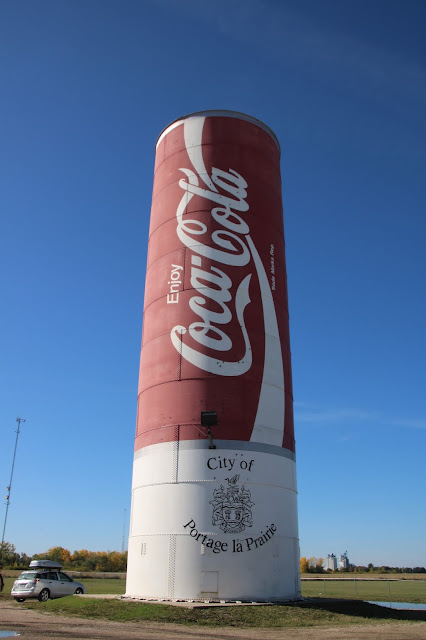September 2017
Brandon did not have much to attract us when we took a drive downtown.
The former Cargill elevator on Pacific Avenue.
The crumbling elevator was once a centrepiece of the city’s economy as farmers trucked grain to the Wheat City, where it would be loaded into railcars and sent east and west to market.
The faded decals of "Cargill," "National" and "McCabe" are still visible on the side of the building as a reminder of the ghosts of grain companies past.
It's nice to have a short driving day!
This former water tank is 85 feet tall. It was moved from the City's water treatment plant quite a few years ago and Coca-Cola paid for the original paint job.
.
We haven't seen this before.
Originally, the ground floor housed the Post Office while the upper floor held the Customs and Revenue Office. Political controversy in Ottawa delayed construction, but the building was finally opened in 1898. In 1920, an addition was made on the south side. The building became the Portage la Prairie City Hall in 1960 and has provided spaces over the years for the Magistrate’s Court, Youth Court, RCMP detachment (with its jail cells), library and arts centre.
A plaque was erected beside the building in 1983 by the Historic Sites and Monuments Advisory Board of Canada. It commemorated the building as a representative of small, urban post offices designed by Thomas Fuller, and the fact that it was largely intact and had not undergone major exterior renovation.
Trinity United Church traces their roots back through the Presbyterian and Methodist Churches of Portage la Prairie and surrounding area.
The present building was built by the Presbyterian ancestors as Knox Presbyterian Church in 1897. Methodist ancestors built a church in 1880 (and rebuilt in 1891 following a fire) called Grace Methodist Church.
In 1925, The United Church of Canada was created by the Union of the Methodist, Presbyterian and Congregationalist Churches of Canada as well as a number of Local Union Churches scattered primarily through Western Canada. Both Grace Methodist Church and Knox Presbyterian Church became part of the United Church of Canada as Grace United and Knox United respectively.
The Manitoba Legislative Building (French: Palais législatif du Manitoba) is the meeting place of the Legislative Assembly of Manitoba. The neoclassical building was completed in 1920 and stands seventy-seven metres tall (253 ft). It was designed and built by Frank Worthington Simon (1862–1933) and Henry Boddington III, along with other masons and many skilled craftsmen.
I was sure this was another of Fairmont's historic hotels but it isn't/
We drove to the Canadian Museum of Human Rights as we missed the entrance we drove across the bridge.
Esplanade Riel is a pedestrian bridge named in honour of Louis Riel.
It is a side-spar cable-stayed bridge which spans the Red River connecting downtown Winnipeg with St. Boniface; it is paired with a vehicular bridge, the Provencher Bridge. The bridge includes an architectural composite tower that is prestressed with a cantilevered and stayed semi-circular plaza area at the base of the tower. The plaza provides space for commercial activities and as well as a restaurant.
The Esplanade Riel is the only bridge with a restaurant in North America.
The museum is magnificent!
Gophers abound.
Some photos snapped as we drive to the hotel.
Weekly recap with more photos
Day 5 - Denver CO to Rapid City SD
The Curtis Hotel Denver CO funky themed floors
Day 6 - Rapid City SD Mount Rushmore City of Presidents
Day 7 - Rapid City SD to Billings MT Crazy Horse and Little Big Horn
Day 8 - Billings MT to Driggs ID
Day 9 - Jackson Hole WY and Grand Teton NP
Day 5 - Denver CO to Rapid City SD
The Curtis Hotel Denver CO funky themed floors
Day 6 - Rapid City SD Mount Rushmore City of Presidents
Day 7 - Rapid City SD to Billings MT Crazy Horse and Little Big Horn
Day 8 - Billings MT to Driggs ID
Day 9 - Jackson Hole WY and Grand Teton NP
Day 13 - Port Angeles WA to Victoria BC
Day 14 - Victoria BC
Day 15 - Victoria BC to Olympia WA
Weekly Recap
Day 16 - Olympia WA to Vancouver BC
Day 17 - Vancouver BC to Kamloops BC
Day 18 - Kamloops BC to Jasper AB
Day 19 Jasper AB to Edmonton AB
Day 20 - Edmonton AB to Medicine Hat AB
Day 21 - Medicine Hat AB to Regina SK
Day 22 - Regina SK to Brandon MB
Day 14 - Victoria BC
Day 15 - Victoria BC to Olympia WA
Weekly Recap
Day 16 - Olympia WA to Vancouver BC
Day 17 - Vancouver BC to Kamloops BC
Day 18 - Kamloops BC to Jasper AB
Day 19 Jasper AB to Edmonton AB
Day 20 - Edmonton AB to Medicine Hat AB
Day 21 - Medicine Hat AB to Regina SK
Day 22 - Regina SK to Brandon MB





























Manitoba's legislature is impressive, as is the very modern style of the new museum.
ReplyDelete